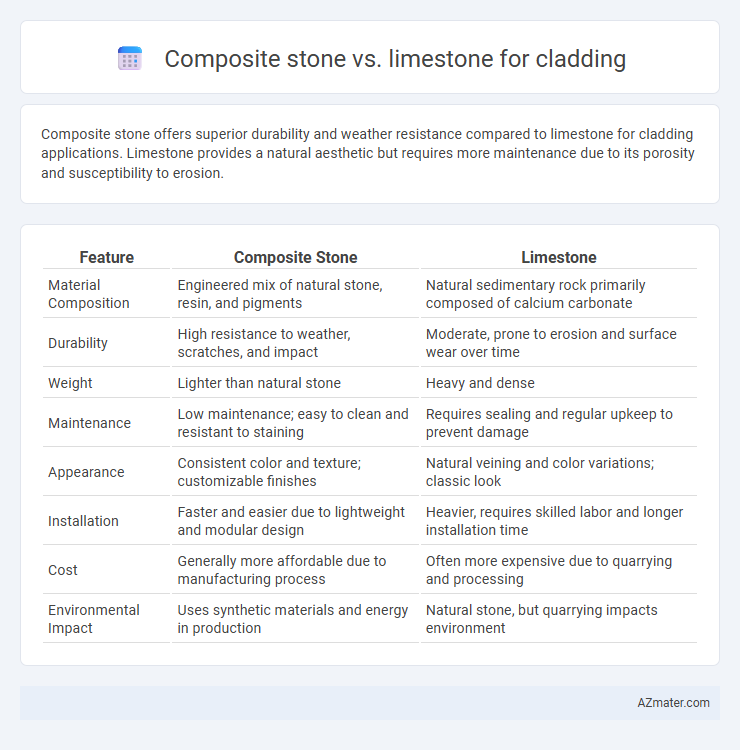Composite stone offers superior durability and weather resistance compared to limestone for cladding applications. Limestone provides a natural aesthetic but requires more maintenance due to its porosity and susceptibility to erosion.
Table of Comparison
| Feature | Composite Stone | Limestone |
|---|---|---|
| Material Composition | Engineered mix of natural stone, resin, and pigments | Natural sedimentary rock primarily composed of calcium carbonate |
| Durability | High resistance to weather, scratches, and impact | Moderate, prone to erosion and surface wear over time |
| Weight | Lighter than natural stone | Heavy and dense |
| Maintenance | Low maintenance; easy to clean and resistant to staining | Requires sealing and regular upkeep to prevent damage |
| Appearance | Consistent color and texture; customizable finishes | Natural veining and color variations; classic look |
| Installation | Faster and easier due to lightweight and modular design | Heavier, requires skilled labor and longer installation time |
| Cost | Generally more affordable due to manufacturing process | Often more expensive due to quarrying and processing |
| Environmental Impact | Uses synthetic materials and energy in production | Natural stone, but quarrying impacts environment |
Introduction to Cladding Materials
Composite stone offers enhanced durability and lightweight benefits compared to traditional limestone, making it ideal for modern cladding applications. Limestone, valued for its natural aesthetic and thermal properties, remains popular in historic and high-end architectural projects. Both materials provide unique textures and weather resistance, but composite stone often requires less maintenance and offers greater design flexibility for exterior facades.
What Is Composite Stone?
Composite stone is a man-made material composed of crushed natural stone, resin, and pigments, engineered to offer enhanced durability and aesthetic versatility compared to natural limestone. Unlike limestone, which is a sedimentary rock known for its softness and susceptibility to weathering, composite stone provides superior resistance to moisture, staining, and impact, making it ideal for exterior cladding applications. Its customizable textures and colors allow architects and designers to replicate the appearance of limestone while benefiting from reduced maintenance and increased longevity.
Limestone: A Natural Classic
Limestone, a natural classic for cladding, offers timeless elegance with its unique fossilized textures and warm, earthy tones that blend seamlessly into various architectural styles. This sedimentary rock provides excellent durability, breathability, and weather resistance, making it ideal for both interior and exterior applications. Compared to composite stone, limestone's natural composition ensures better aging, patina development, and environmental sustainability in building facades.
Durability Comparison: Composite Stone vs Limestone
Composite stone offers significantly higher durability compared to limestone, as it resists cracking, chipping, and weathering due to its engineered composition of crushed stone and resin. Limestone, a natural sedimentary rock, is more prone to erosion, staining, and mechanical damage when exposed to harsh weather conditions and pollutants. For long-term exterior cladding applications, composite stone provides enhanced structural integrity and lower maintenance requirements than traditional limestone.
Aesthetic Differences in Cladding Appearance
Composite stone cladding offers a consistent, uniform appearance with a wide range of color options and textures that can mimic natural stone while providing enhanced durability. Limestone cladding provides a more organic, natural aesthetic characterized by unique veining and subtle color variations that develop patina over time. The choice between composite stone and limestone centers on whether a sleek, customizable look or an authentic, timeless natural appearance is preferred for the architectural design.
Installation Processes and Challenges
Composite stone cladding offers faster installation times due to its lightweight panels and interlocking designs, reducing labor costs and structural support requirements. Limestone cladding demands precise handling and skilled labor because of its heavier weight, susceptibility to chipping, and the need for mechanical fasteners or mortar, increasing installation complexity. Challenges with limestone include managing moisture absorption and ensuring proper sealing, while composite stone requires careful alignment to maintain aesthetic continuity and durability.
Maintenance and Longevity Considerations
Composite stone cladding offers superior durability and low maintenance due to its resistance to weathering, staining, and cracking, making it ideal for long-term applications. Limestone, while aesthetically appealing with a natural texture, requires regular sealing and more frequent upkeep to prevent erosion, discoloration, and damage from moisture. Long-term performance favors composite stone for its enhanced resilience and minimal maintenance requirements compared to the porous and softer nature of limestone.
Environmental Impact and Sustainability
Composite stone cladding offers enhanced sustainability through the use of recycled materials and lower energy consumption during manufacturing compared to natural limestone. Limestone extraction involves significant quarrying processes that disrupt ecosystems and generate high carbon emissions, impacting biodiversity and water quality. Choosing composite stone reduces environmental degradation and supports resource efficiency, making it a more eco-friendly option for sustainable building projects.
Cost Analysis: Composite Stone vs Limestone
Composite stone cladding generally offers a more cost-effective solution compared to limestone, with prices ranging from $20 to $45 per square foot, whereas limestone can cost between $30 and $75 per square foot. Installation costs for composite stone are typically lower due to its lightweight nature, reducing labor time and structural support requirements. Long-term maintenance expenses also favor composite stone, as it resists staining and weathering better than limestone, which may require periodic sealing and repairs.
Choosing the Right Material for Your Project
Composite stone offers superior durability, lightweight handling, and increased resistance to weathering compared to traditional limestone, making it ideal for high-performance cladding applications. Limestone provides natural aesthetic appeal with unique veining and texture, enhancing architectural character in both historical and modern designs. Selecting the right material depends on factors such as project budget, desired visual effect, structural load capacity, and environmental exposure conditions.

Infographic: Composite stone vs Limestone for Cladding
 azmater.com
azmater.com